
The other COVID side effect: The Great Employee Resignation

Ms. Pomerantz is the CEO of TPG HR Services USA and has over 35 years of Human Resources practices experience. She holds a Master’s in Human Resource Management (MHRM) and is a certified Senior Professional in Human Resources (SPHR) and SHRM Senior Certified Professional (SHRM-SCP). Mary also serves as CEO of Mary Pomerantz Advertising, one of the largest recruitment advertising agencies in the country. Earlier in her career, she was president of the 17th largest staffing firm in the country.

According to the Bureau of Labor Statistics, US workers are voluntarily quitting their jobs at record-breaking rates across almost all segments of the economy. The numbers are staggering; in the month of August alone, 4.3 million people – around 2.9 percent of the workforce – voluntarily quit their jobs in the US. This great employee resignation is fueled in large part by workers who have emerged from the economic downturn of the COVID pandemic frustrated and expressing decreasing job satisfaction. Reasons often include having to work inconvenient hours and/or stagnant compensation with fewer benefits. Adding to the problem, job openings are approaching near-record rates making recruitment increasingly more difficult. As a result, workers feel they have gained considerable leverage and many have chosen to resign. Even more surprising is many of those who have resigned have made the decision to wait before they start considering a new job that they believe will better fit their individual needs. [1]
Americans are voluntarily quitting their jobs at a record-breaking rate.
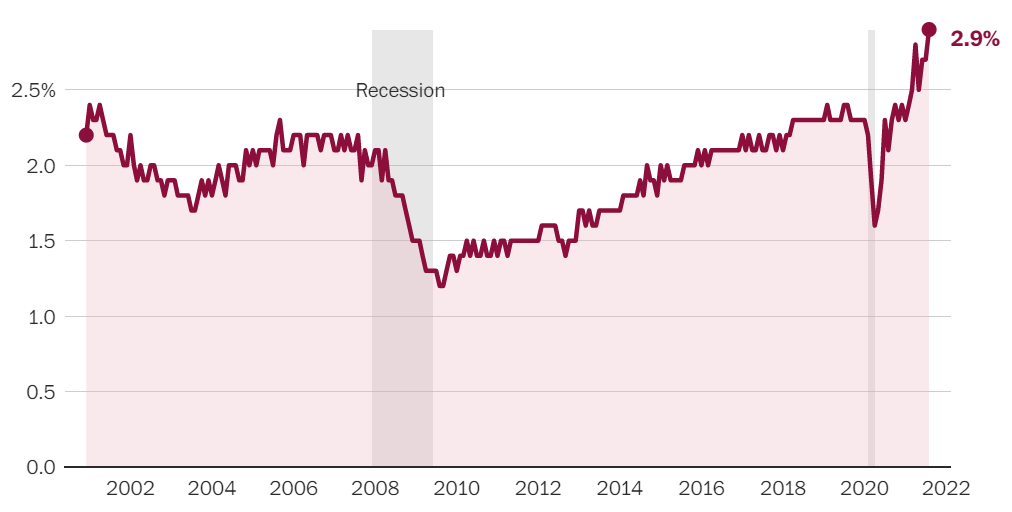
The Great Employee Resignation hits certain sectors harder than others
Although workers are leaving their jobs in record numbers across a broad swath of the US economy, certain sectors have been much harder hit than others. In particular, low-wage service sector employees are leaving their positions in massive numbers, often in search of more rewarding and less demanding positions in other sectors of the economy. For example, nearly 2 in 5 workers who quit in August 2021 worked in retail or in restaurants and hotels, many from traditionally low-wage service sector positions. The following graphs illustrate how the great resignation has statistically impacted several major sectors of the US economy. [1]
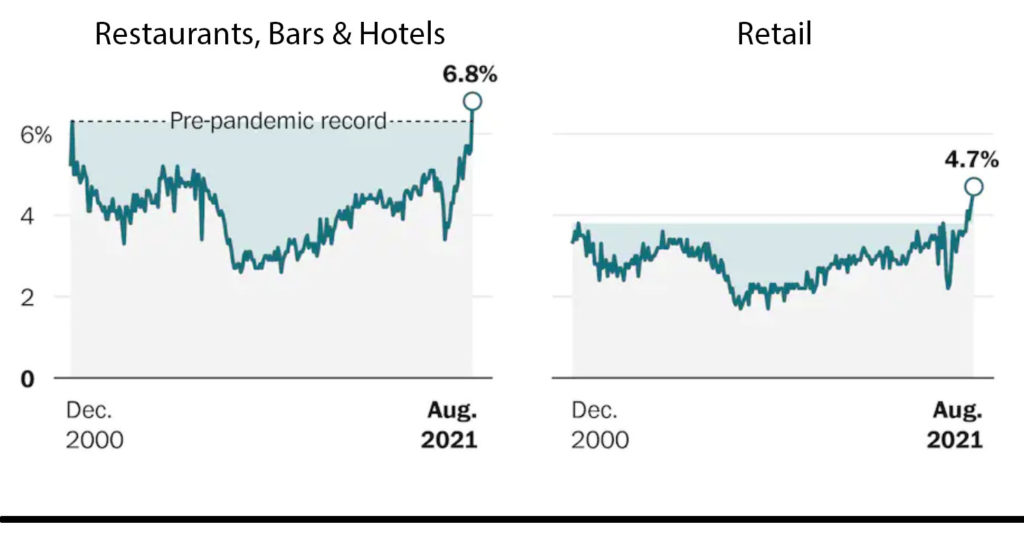
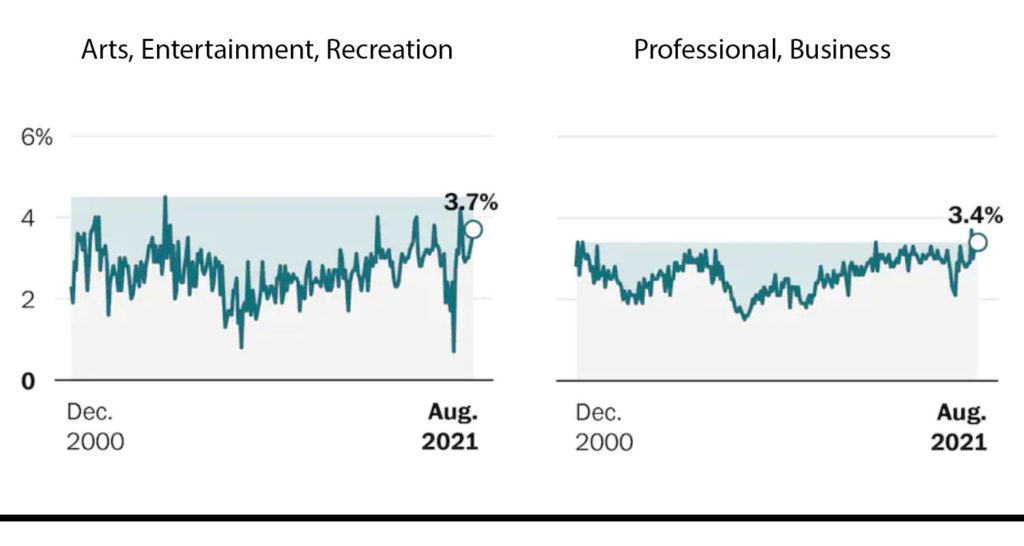
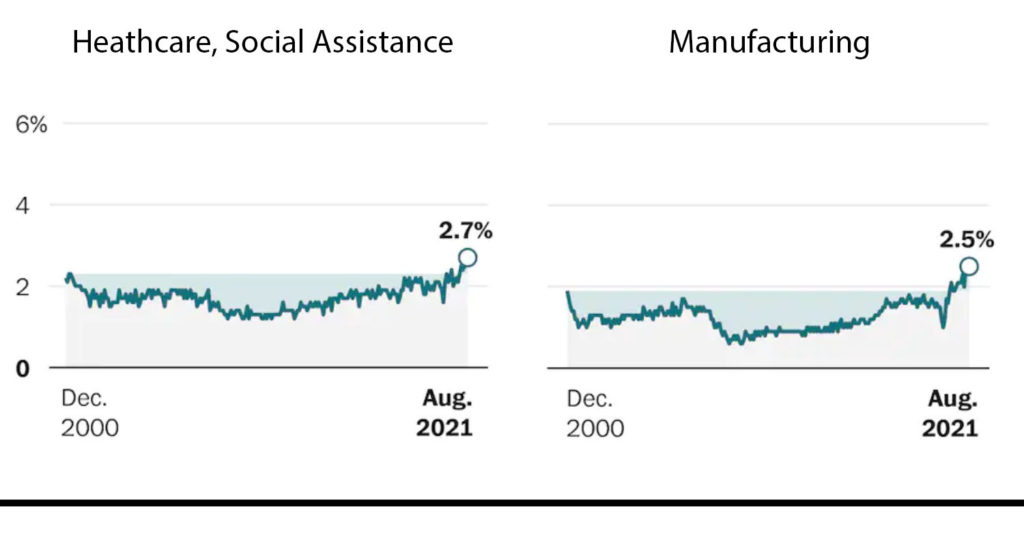
Many workers seek new jobs in sectors with
more remote work options
Data from recruitment site ZipRecruiter backs up what the variation in voluntary quit rates seems to imply – that many workers are seeking new jobs in sectors where work is more likely to be able to be done remotely. Some of this desire is directly related to pandemic-related fears of COVID exposure, while other workers simply seek the greater flexibility that remote work offers in terms of work/life balance. And, with the increase in remote work opportunities brought on by the pandemic, these workers have the potential to seize upon these opportunities, perhaps for the first time in their working lives. [1]
The Great Employee Resignation has affected some geographic regions more than others
Just as the voluntary quit rates vary significantly across sectors of the economy, one’s geographic location also seems to have a substantial impact on the intensity of the phenomenon as well. In fact, based on data from a recent Bureau of Labor Statistics report, some states have more than double the voluntary quit rates of others. There are multiple reasons for this significant variability across states, but much of this geographic variability – like the sector variability previously noted – is also pandemic related. States that have experienced high COVID transmission rates over extended periods of time have experienced much higher voluntary quit rates than those that have not. This suggests that concern over COVID exposure has fueled a significant portion of the “job churn” as people seek safer work environments amid the pandemic. [2]
Voluntary employee resignation rates by state
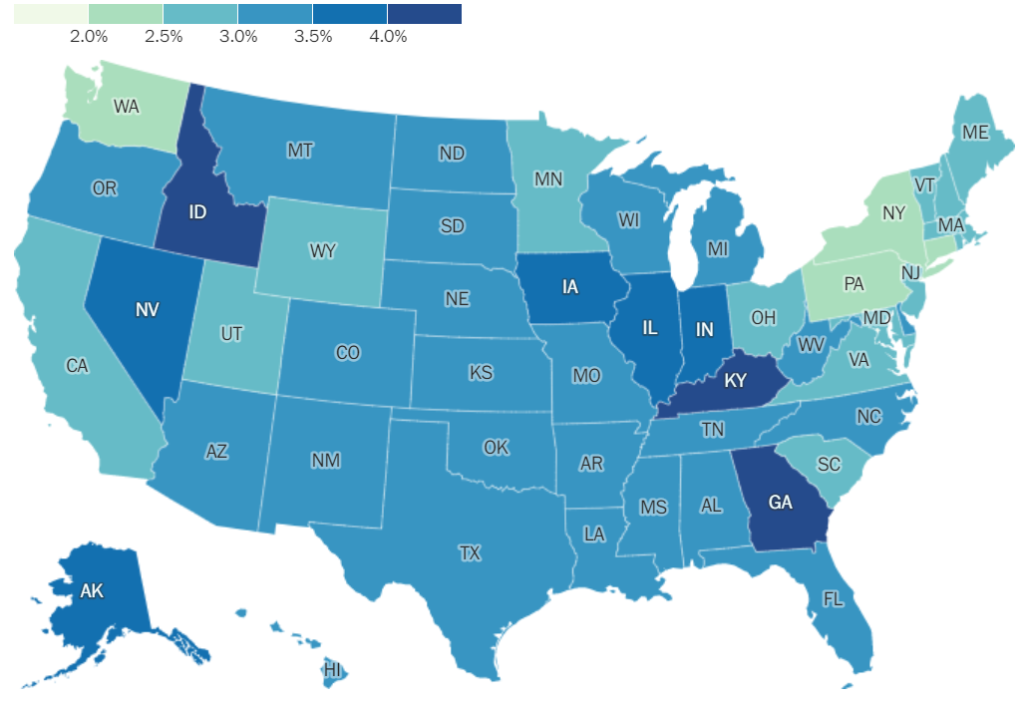
Companies new acceptance of remote work has created opportunities for workers living in rural states
As more companies offer remote work opportunities, individuals in rural areas who may have once had limited employment options increasingly can pick and choose from a diverse array of available remote work positions. This dramatic increase in employment options is certain to have had an impact on the voluntary quit rates in these areas, at least partially explaining why states such as Idaho, Kentucky, and Georgia appear at the top of the list when quit rates are compiled. This dramatic change in the way in which work is done should continue to fuel worker mobility, even once the current pandemic abates in intensity. The old adage spawned by the post-WWI song “How Ya Gonna Keep ’em Down on the Farm After They’ve Seen Paree?” might be appropriate to describe how the changing nature of work may have permanently changed the employment equation for workers, particularly those from rural areas. [2]
How an employee’s age impacts the likelihood of joining The Great Employee Resignation
According to a recent Harvard Business Review article, voluntary resignations also show significant variability across different segments of the working population when divided by age group. While the youngest group of workers (20-25 years old) typically has the largest resignation rates among all age groups, that was not the case during the last year. In fact, resignations actually decreased among this group of workers from 2020 to 2021. Resignations also declined for workers in the 60-70-year-old age group during this period. However, these small decreases in voluntary resignations were more than offset by higher resignation rates among employees of other age groups. In particular, employees among the 30–45-year-old age group saw the largest rise in resignations, with a more than 20% increase in voluntary resignations from 2020 to 2021. For employees seeking to stem the tide of the Great Resignation, understanding the possible reasons for this age discrepancy might be critical for designing a plan to retain the current employees. [3]
What can employers do to mitigate the negative impact on their workforce during The Great Employee Resignation
Faced with an increasingly difficult struggle to retain the skilled workforce that any company needs to succeed, it is natural to ask the question, “how can our company best respond to increased employee willingness to voluntarily resign from positions in our organization?” The first important step is to gain a detailed understanding of the specific situation at your company, based on actual data. This can help you determine how many people are quitting compared to historical baselines, which employees have the highest turnover risk, why employees are considering or actually leaving, and what can be done to prevent or mitigate the outflow of skilled employees from your organization.
According to the Harvard Business Review, a 3-step approach to this problem has the best chance of being successful:
- Quantify the problem
- Identify the root causes
- Develop and implement tailored retention programs
[3]
Step 1: Quantifying the problem of voluntary resignations
Before your company can respond to the impact of the Great Resignation on your organization, you need to get an accurate sense of the scope of the problem, based on accurate data. This begins by calculating the overall employee turnover rate for your business. The following formula will yield that result, enabling you to compare it to previous years and measure the results of any retention efforts you later put in place:

Once you have established the employee turnover rate for your company, you can further break it down into voluntary resignations versus firings and layoffs, etc. This will give you a data-driven tool for examining where any employee retention problems may lie in your organization. Another part of “quantifying the problem” is calculating the impact on key business metrics that voluntary resignations are having at your organization. This can include the “sunk costs” of things like training and development that walk out the door when an employee leaves to the many opportunity costs associated with having a workforce that must constantly adjust to shifting staffing levels and skill sets. Estimating the true cost of voluntary resignations to your company’s bottom line is a critical component of designing any sort of solution to this issue.
Step 2: Identifying the root causes of voluntary resignations
After you understand the scale of your retention problem, you can look to identify the root causes within your organization. Although there are clearly large-scale economic and social phenomena fueling the nationwide Great Resignation, often the solutions at any given company are much more specific and targeted to individual conditions and issues. A good start to this process is analyzing metrics such as compensation, the time between promotions, training opportunities, and other data points that can give you a clearer picture of any areas in which your organization may be lagging behind industry standards or best practices. Oftentimes, working with an outside and independent partner like TPG HR Services is the best way to get a clear and objective analysis of these issues.
The main causes of voluntary employee resignation
- Career progression
- Management issues
- Job dissatisfaction
- Toxic organizational culture
- Lack of flexibility
- Lack of learning opportunities
- Poor compensation
- Fatigue / exhaustion
[4]
Also, since many individuals leave organizations based upon negative interactions with their immediate supervisors, identifying (and re-training or even removing) problematic managers can often have a dramatic positive impact on employee retention. It may initially seem counter-intuitive to remove a supervisory employee in a time of labor shortages, but it can actually help improve your employee retention rate significantly if that employee was the root cause of many others leaving the organization. This is another area where an outside HR service provider such as TPG HR Services can be extremely helpful. By conducting exit interviews and surveying current employees anonymously, we can help you to identify any managers who may create a work environment that drives away your valuable talent at a time when it is increasingly difficult to replace it.
Step 3: Developing and implementing tailored retention programs
After identifying the root causes of employee turnover at your organization, you can start to tailor retention programs aimed at addressing the specific issues that your company experiences. For example, if you determine that employees perceive your internal promotion rates as too slow, you may want to examine ways to speed up or adjust your processes related to career advancement within your organization. Issues such as dissatisfaction with compensation or benefits may warrant a review of your salary or benefit levels. In addition, issues with specific supervisors may cause you to invest in retraining or enhanced oversight of specific managers or even the termination of especially problematic managers who are consistently “driving away” talented staff. Furthermore, this sort of data-driven review can also uncover diversity-related issues which may need to be addressed to ensure that all your employees feel valued and appreciated in your organization.
How TPG HR Services can help
For assistance in developing these sorts of tailored retention programs for your company, it is often helpful to employ an objective, outside partner such as TPG HR Services that can help you “see the forest through the trees” and even conduct employee interviews and data gathering and analysis efforts. This can ensure that you get an honest, unbiased assessment of your workplace culture, enabling you to design the best possible approach to solving any specific workplace issues that may be fueling voluntary resignations from your company. Although the Great Resignation is affecting all employers in this uncertain time, there are concrete steps that you can take to ensure that your company can weather the storm and come out stronger and more competitive on the other end of this current crisis.
